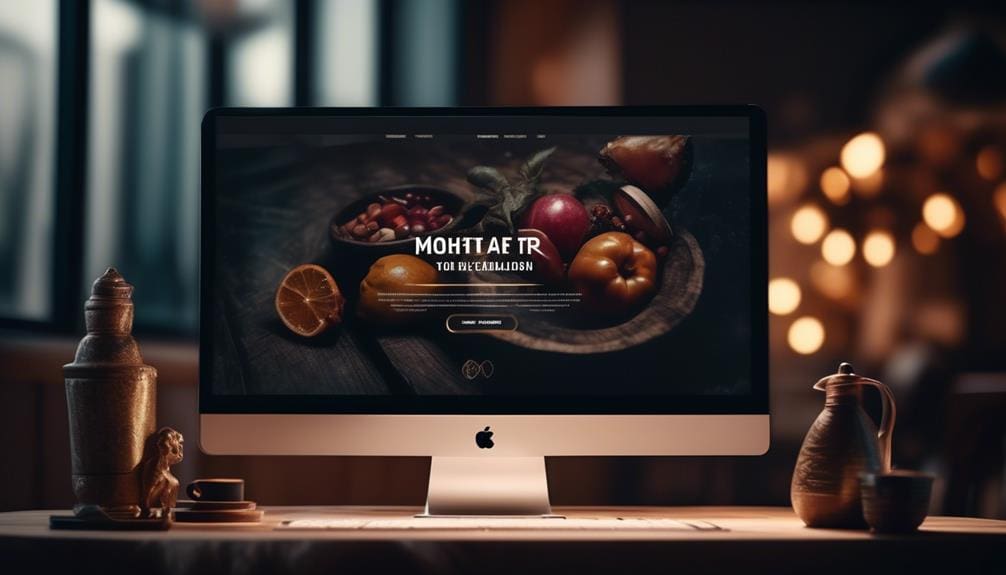Limited Access: Transform Your Email Campaigns With Irresistible Template Designs
Did you know that 70% of people say they will immediately delete an email if it doesn't look good on their mobile device? With the increasing use of smartphones and tablets, it has become crucial for businesses to optimize their email campaigns with irresistible template designs.
But how can you create email templates that captivate your audience and drive engagement? In this discussion, we will explore the importance of eye-catching designs, the elements of a successful email template, and strategies for incorporating your brand identity.
Stay tuned to discover how to transform your email campaigns and achieve remarkable results.
Key Takeaways
- Eye-catching designs are crucial for email campaigns as they increase open rates and engagement.
- Incorporating brand identity into email templates strengthens the connection with the audience.
- Creating engaging call-to-actions with compelling visuals and persuasive language improves conversion rates.
- Driving click-through rates can be achieved by using action-oriented language, prominently displayed CTAs, and personalization based on user behavior.
Importance of Eye-catching Designs

Eye-catching designs are essential for capturing the attention of your recipients and increasing the likelihood that they'll engage with your emails. In today's fast-paced digital world, where people receive numerous emails daily, it's crucial to stand out from the crowd. By using eye-catching design techniques, you can make your emails visually appealing and impactful, thereby maximizing your email open rates.
Visuals have a significant impact on email open rates. Studies have shown that emails with captivating visuals are more likely to be opened and read compared to plain text emails. When your recipients see an email with an eye-catching design, they're more likely to be intrigued and curious about its content. This curiosity leads them to open the email and explore further.
Eye-catching design techniques can include using vibrant colors, bold typography, and striking images. By incorporating these elements, you can create visually compelling emails that grab attention and entice recipients to take action. Additionally, well-designed emails can convey professionalism and credibility, making your brand more trustworthy in the eyes of your audience.
Elements of a Successful Email Template
To create a successful email template, you need to focus on key elements that will engage your recipients and drive them to take action. One of the most crucial elements is creating effective subject lines. A catchy subject line can grab your recipient's attention and entice them to open your email. It should be short, concise, and personalized to make it more compelling.
Improving email deliverability is essential to ensure that your emails reach the intended recipients' inboxes. To achieve this, you should prioritize building a clean and engaged email list, regularly updating and maintaining your subscriber database, and using reputable email service providers. These steps won't only improve your email deliverability but also help you establish trust with your recipients, increasing the chances of your emails being opened and read.
Incorporating Brand Identity Into Templates

As you focus on creating effective email templates, it's crucial to infuse your brand identity seamlessly into the design. Incorporating your brand's unique personality and values won't only help your emails stand out but also strengthen the connection with your audience. To achieve this, you can employ various branding techniques and leverage color psychology.
Start by using your brand logo, colors, and fonts consistently throughout the email template. This will create a cohesive look and feel that's instantly recognizable as your brand. Additionally, consider incorporating your brand's tagline or mission statement in a prominent place within the template. This will reinforce your brand's message and values.
When it comes to color psychology, choose colors that align with your brand's personality and evoke the desired emotional response. For example, if your brand is energetic and vibrant, consider using bold and bright colors. On the other hand, if your brand is more calm and soothing, opt for softer and muted colors. Understanding the psychological impact of colors will help you create a visually appealing and emotionally engaging email template.
Tips for Creating Engaging Call-to-Actions
Ready to take your email marketing to the next level?
Learn how to create captivating call-to-actions that drive higher click-through rates and increase conversions.
In this article, we'll share essential tips for designing engaging CTAs that grab attention and encourage your audience to take action.
Don't miss out on the opportunity to optimize your email campaigns and achieve better results.
Let's get started!
Captivating CTA Designs
For captivating CTA designs that engage your audience, consider incorporating compelling visuals and persuasive language. A well-designed call-to-action can significantly increase your CTA conversion rates and drive more action from your recipients.
Here are some tips to create engaging CTAs:
- Visual Appeal:
- Use eye-catching colors and images that align with your brand and message.
- Make sure your CTA stands out from the rest of the email by using contrasting colors or bold fonts.
- Persuasive Language:
- Use action-oriented verbs that encourage your audience to take immediate action.
- Highlight the benefits or value they'll receive by clicking on your CTA.
Driving Click-through Rates
To boost your click-through rates and create engaging call-to-actions, implement these proven strategies.
First, make your CTA clear and compelling by using action-oriented language that creates a sense of urgency. Use keywords that resonate with your audience and highlight the benefits they'll receive by clicking.
Second, optimize the placement and design of your CTA. It should be prominently displayed and visually appealing, with contrasting colors and clear, easy-to-read text.
Third, personalize your CTAs based on user behavior and preferences. Use dynamic content to tailor the message and offer to each individual recipient.
Personalization and Segmentation Strategies

Implementing personalized and segmented email strategies can greatly enhance your campaign's effectiveness and engagement rates. By tailoring your emails to meet the specific needs and preferences of your recipients, you can create a more personalized and relevant experience for them. This level of personalization can lead to higher open rates, click-through rates, and ultimately, more conversions.
Here are two key reasons why you should consider implementing email personalization techniques and segmenting your email list:
- Increase Relevance: Personalization allows you to address your recipients by their name and tailor the content of your emails based on their preferences, behavior, or past purchases. By providing relevant and targeted information, you demonstrate that you understand their needs and interests, which can significantly enhance engagement and conversion rates.
- Improve Engagement: Segmenting your email list allows you to divide your subscribers into smaller, more targeted groups based on demographics, interests, or purchase history. This enables you to send more focused and personalized emails that resonate with each segment. By delivering content that's highly relevant to your recipients, you can increase their engagement and build stronger relationships with them.
Optimizing Templates for Mobile Devices
Ensure your email templates are optimized for mobile devices to maximize engagement and reach your audience wherever they are. With the increasing number of people accessing emails on their smartphones and tablets, it's crucial to have a responsive design that adapts to different screen sizes.
A well-optimized email layout ensures that your message is easily readable and visually appealing on mobile devices.
To create a responsive design, consider using a single-column layout, as it provides a better user experience on smaller screens. Avoid using too many images or large files that may slow down loading time. Optimize your email templates by using HTML and CSS coding techniques that automatically adjust the layout based on the device being used.
Furthermore, make sure your email templates are compatible with popular email clients and apps. Test your templates on different devices and platforms to ensure they render correctly and are easily navigable. Incorporate mobile-friendly features like large fonts, clear call-to-action buttons, and concise content to enhance the user experience.
Testing and Analyzing Template Performance

Testing and analyzing template performance is essential for optimizing your email marketing strategy and ensuring maximum engagement with your audience. By regularly testing your email templates, you can identify what works best for your subscribers and make data-driven decisions to improve your campaigns.
Here are some key points to consider:
- Testing frequency: It's important to establish a consistent testing schedule to gather enough data for meaningful insights. Conducting tests too frequently may not yield accurate results, while testing too infrequently may delay the optimization process. Find a balance that allows you to gather enough data without overwhelming your resources.
- A/B testing methods: A/B testing involves creating two versions of your email template and sending them to different segments of your subscriber list. By comparing the performance of each version, you can determine which design, copy, or call-to-action resonates better with your audience. This method allows you to make incremental changes and continuously improve your templates over time.
Regularly testing and analyzing your template performance is a crucial part of refining your email marketing strategy. By finding the right testing frequency and utilizing A/B testing methods, you can ensure that your templates are optimized to engage your audience and drive the desired results.
Staying Ahead With Updated Email Design Trends
Stay ahead of the competition by staying up-to-date with the latest email design trends. In the fast-paced world of email marketing, it's crucial to keep your campaigns fresh and engaging. By incorporating the latest design trends into your emails, you can capture your audience's attention and drive better results. Here are some email design best practices and tips to help you stay ahead:
| Column 1 | Column 2 | Column 3 |
|---|---|---|
| Mobile-first design | Personalization | Interactive elements |
| Clean and minimalist layout | Bold typography | Dark mode compatibility |
| Eye-catching visuals | Animated GIFs | Microinteractions |
| Clear and concise messaging | A/B testing | Accessibility optimization |
| Dynamic content | Social media integration | Customizable templates |
Mobile-first design is essential in today's mobile-centric world. Ensure that your emails are optimized for mobile devices, as most people now read emails on their smartphones. Personalization is another key trend, as it helps create a more tailored and relevant experience for your subscribers.
Incorporating interactive elements, such as polls or quizzes, can boost engagement and encourage interaction with your emails. Bold typography and eye-catching visuals can help grab attention and make your emails stand out in crowded inboxes.
Consider using animated GIFs and microinteractions to add a touch of interactivity and visual interest to your emails. Keep your messaging clear and concise, and don't forget to optimize for accessibility to ensure that everyone can easily access and understand your content.
Dynamic content and social media integration can also enhance the overall user experience. Lastly, using customizable templates and conducting A/B testing can help you find the designs that resonate best with your audience.
Frequently Asked Questions
How Can I Create Eye-Catching Designs for My Email Campaigns?
You can create eye-catching designs for your email campaigns by incorporating captivating visuals and designing attractive layouts. Grab your audience's attention with compelling imagery and a well-structured format.
What Are the Essential Elements That Make a Successful Email Template?
To create a successful email template, focus on best practices like clean design, clear call-to-action, and personalized content. Don't forget the importance of mobile optimization to ensure your emails look great on any device.
How Can I Incorporate My Brand Identity Into My Email Templates Effectively?
Incorporate your brand identity into email templates effectively by ensuring brand consistency and customizing your templates. This will create a cohesive and recognizable look that resonates with your audience, increasing engagement and trust.
What Are Some Tips for Creating Engaging Call-To-Actions in Email Campaigns?
To create engaging call-to-actions in your email campaigns, focus on conversion optimization and use effective copywriting techniques. Craft clear and compelling messages, use persuasive language, and make it easy for your audience to take action.
How Can I Personalize and Segment My Email Campaigns to Improve Engagement?
To improve engagement, personalize your email campaigns by using personalization strategies like addressing recipients by name and tailoring content to their interests. Segment your audience based on demographics or behavior to send targeted messages that resonate with them.
Conclusion
Transforming your email campaigns with irresistible template designs is crucial for capturing your audience's attention and driving engagement. By incorporating eye-catching elements, aligning with your brand identity, and creating engaging call-to-actions, you can enhance the effectiveness of your emails.
Personalization and segmentation strategies, along with optimizing for mobile devices, further improve your chances of success. Stay ahead of the competition by constantly testing, analyzing, and staying updated with the latest email design trends.
Start transforming your email campaigns today and see the difference it makes in achieving your marketing goals.








